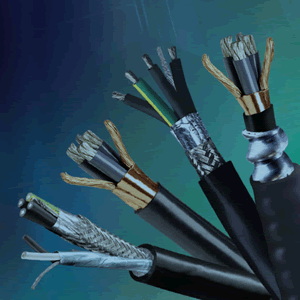How to Select Cable for Variable Frequency Drive Systems
Excessive electrical noise in variable frequency drive installations can wreak havoc on the precision electronic components, network cabling, and other sensitive wiring found in most modern industrial facilities. Belden’s Peter Cox explains how to select cable for variable frequency drive systems.
 Many existing variable frequency drive (VFD) installations use cross-linked high heat water resistant insulated wire (XHHW); thermoplastic high-heat-resistant, nylon-coated (THHN) building wire in conduit (pipe and wire systems); or interlocked armor UL 1569 – Metal Clad (MC) – CSA TECK 90; or continuously welded and corrugated aluminum armor (CCA) cable to connect from the VFD to the motor. These cable types will release excessive electrical noise in many installations, and this electrical noise can wreak havoc on the precision electronic components, network cabling, and other sensitive wiring found in most modern industrial facilities.
Many existing variable frequency drive (VFD) installations use cross-linked high heat water resistant insulated wire (XHHW); thermoplastic high-heat-resistant, nylon-coated (THHN) building wire in conduit (pipe and wire systems); or interlocked armor UL 1569 – Metal Clad (MC) – CSA TECK 90; or continuously welded and corrugated aluminum armor (CCA) cable to connect from the VFD to the motor. These cable types will release excessive electrical noise in many installations, and this electrical noise can wreak havoc on the precision electronic components, network cabling, and other sensitive wiring found in most modern industrial facilities.
The solution is to specify, and properly install, VFD cable with a foil braid or copper tape shield and suitable ground wires. Compared to pipe and wire, MC, TECK or CCA, properly terminated VFD cable provides superior performance in terms of common mode current (CMC) containment and in other areas.
With properly installed VFD cable, CMC is effectively contained within the cable, then returned back to the ground point of the VFD. With either pipe and wire, MC, TECK or CCA cable, CMC may be returned back to the VFD enclosure metal. Returning the current to the enclosure causes electrical noise to radiate from the enclosure into surrounding areas. This radiated electrical noise, commonly referred to as electromagnetic interference/radio frequency interference (EMI/RFI), can often cause certain electronic components, cabling, and wiring to malfunction.
The superior performance of VFD cable can result in reduced drive system faults, process upsets, and safety circuit trips in adjacent circuits, and enhanced signal integrity for critical process measurements. These and other advantages of VFD cable can be garnered for a relatively low price, particularly as compared to the cost of the entire VFD and motor installation.
Although noise generated by improperly contained CMC is the most compelling reason to use VFD cable, there are other factors that favor its use.
VFD Cable Specifics
VFD cable features grounding systems that are specifically designed for the application. These systems utilize much more copper (up to 300%) in the grounds to reduce induced and coupled ground currents. In a VFD specific design, the grounds and conductors use a flexible high-surface-area conductor for optimal high-frequency performance. For higher-power applications, VFD cables utilize symmetric grounds to reduce induced currents. MC and TECK have neither the grounds size nor symmetry required to reduce ground currents and potential difference. For longer runs with drives over 100 HP, the lack of symmetric grounds cable results in the introduction of excessive current noise into the grounding system.
So non-VFD specific solutions not only generate more current noise due to the lack of symmetric grounds, but also radiate more of this noise into the environment due to intermediate termination of shields at the VFD enclosure instead of the VFD itself.
MC and TECK cables are constructed with shields in a spiral path. This spiraling creates an inductor, which cannot carry the high-frequency components of common mode current, forcing those components to travel through other paths outside of the cable, creating excess EMI/RFI.
High performance VFD cables use either a braided, shield or a double copper tape with contra-helical application to maximize surface area for high-frequency conduction and to minimize the inductive effects of a single tape. VFD cable is suitable for installation in either conduit or cable trays, while TECK and CCA cable are not designed for installation in conduit. For plants that prefer to run cable in conduit, this can be a compelling reason to use VFD cable. VFD cable is also much more flexible than TECK or CCA cable, making installation within a cable tray easier.
Reflected wave voltage may produce potentially destructive voltage stress on the motor insulation. Cabling that is specially designed for VFD-to-motor connections will not eliminate reflected wave voltages, but their lower capacitance conductors will effectively increase the allowable cable distance before experiencing significant buildup of reflected waves. In some cases, the difference in allowable cable length can be as much as three times farther with VFD cables.
Any cable with more than three conductors, not including ground, increases cable-charging losses due to conductor capacitive interaction. None VFD cable is often installed with more than three conductors. These cables can potentially interact with other cables in the system inducing voltages and increasing cable losses.
VFD Cabling Specification and Installation
To prevent excess current that may damage drives during events such as line disturbances or certain types of ground faults, drives should have a minimum amount of upstream impedance. In many installations, this impedance comes from the supply transformer and the supply cables. In certain cases, an additional transformer or reactor is recommended to minimize impedance.
When the cable impedance closely matches the motor impedance, the voltage pulse from the VFD causes little issue. However, when the motor impedance is much larger than the cable impedance, the pulse reflects at the motor terminals, causing standing waves. Since matching cable and motor impedance is a practical impossibility, a best practice is to select cabling from the VFD to the motor such that offers the lowest capacitance, thus storing the least energy available for reflected wave buildup.
Drive cable shields should always be terminated at the motor and at the drive, any intermediate termination of the ground or shield is not recommended. The shield acts as a conductor for CMC, so proper termination is essential. Many effective cable solutions are undone by the use of conductive cable glands that release the common mode current noise before it is safely back to the drive, often at enclosure ingress, effectively reducing a VFD cable solution to the same performance and shortcomings seen in pipe and wire systems.
The VFD PE terminal should be wired to a cabinet PE bus bar, thus providing electrical ground continuity. An appropriate-sized single ground conductor leaving the cabinet must then be bonded to the true earth zero voltage ground. This ensures safe touch voltage potentials exist under ground-fault conditions. Grounding provides a path for undesirable currents to be safely managed, but the voltages as a result of harmonics can still be quite significant. These problems can be compounded if care is not taken in the selection of the wiring and cabling used to connect a VFD to its associated motor.
Failure to terminate the shields and grounds properly can result in harmful electrical noise flowing in the ground grid or radiated to the surrounding environment. Intermediate grounding of the shield can cause the unintended release of shield currents and resulting electrical noise.
VFD cable is designed to be terminated at the motor and at the drive, minimizing the release of electrical noise into the surrounding environment. Pipe and wire, MC, TECK and CCA cable are designed to be terminated at the drive enclosure, which causes electrical noise to radiate from the enclosure into surrounding areas.
Care should be taken when selecting a cable gland to ingress any enclosure. The role of the shielding and grounds in creating an effective CMC containment system can be compromised or rendered ineffective by improper gland selection, so it’s important to select a gland with a suitable rating for ingress protection and with the proper environmental classification.
Though careful consideration should be given to any system that utilizes conductive cable glands and their potential for harmful current release, like any other conductor, a conductive gland should carry an applicable agency listing such as UL, CSA, or IEC. For non-conductive cable glands, the correct degree of ingress protection must be considered for each application.
When drives are mounted in enclosures which contain sensitive items such as analog signals, programmable logic controllers (PLCs), and input/output (I/O) modules, non-conductive glands are recommended. Shields and jackets should be left intact until the cable enters the drive proper to ensure maximum protection from current and noise release. Use of a conductive gland provides a release point for shield currents and related noise, with current levels often high enough to be measured in amps, or even tens of amps.
In addition to releasing ground and shield currents prematurely, the use of a conductive gland also implies that within the enclosure the cable would be unshielded, creating a great potential for radiated noise in a very sensitive environment. Some manufacturers offer shielding kits, for use inside the enclosure, but again these kits are difficult to fit effectively and will introduce additional contact points for noise release.
Some credible gland manufacturers offer isolation bushings, with grounding lugs for shield contact. These can be effective in preventing the release of shield noise into the enclosure metal and can be effective if the cable contains insulated ground conductors.
Selecting and installing the right cable for VFD motor connections mitigates or eliminates many of the issues that can arise from the inherent characteristics of VFD installations. A relatively small investment in proper design, selection, and installation of the right VFD motor cabling increases reliability, improves safety, and reduces maintenance.
This article is excerpted from a white paper originally published on Belden’s website. Click here to read the paper in its entirety.
Peter Cox is a licensed professional engineer and project manager at Belden.





